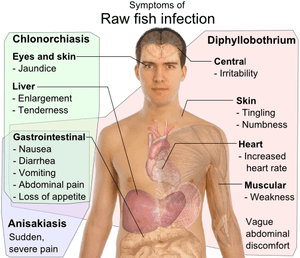Clonorchiasis
Clonorchiasis is an infectious disease caused by the Chinese liver fluke, Clonorchis sinensis, and two related species. Clonorchiasis is a known risk factor for the development of cholangiocarcinoma, a neoplasm of the biliary system.
| Clonorchiasis | |
|---|---|
 | |
| Differential symptoms of parasite infection by raw fish: Clonorchis sinensis (a trematode/fluke), Anisakis (a nematode/roundworm) and Diphyllobothrium a (cestode/tapeworm),[1] all have gastrointestinal, but otherwise distinct, symptoms.[2][3][4][5] | |
| Specialty | Infectious disease, medical parasitology |
Symptoms of opisthorchiasis caused by Opisthorchis viverrini and by Opisthorchis felineus are indistinguishable from clonorchiasis caused by Clonorchis sinensis,[6] so the disease by these three parasites should be referred as clonorchiasis.[6]
Cause
Clonorchiasis sinensis is a trematode (fluke) which is part of the phylum Platyhelminthes. It is a hermaphroditic fluke that requires two intermediate hosts. The parasitic worm is as long as 10 to 25mm and lives in the bile ducts of the liver. The eggs of the worms are passed through fecal matter which are then ingested by mollusks. One becomes infected by eating undercooked, smoked, pickled salted freshwater fish. Freshwater fish are a second intermediate host for the parasitic worm. They become infected when the larvae (cercaria) of the worm penetrates the flesh of the fish. The water snail is the first intermediate host in which a miracidium (an embryonated egg discharged in stool) goes through its developmental stages (sporocyst, rediae and cercariae). Clonorchiasis is endemic in the Far East, especially in Korea, Japan, Taiwan, and Southern China. Clonorchiasis has been reported in non endemic areas (including the United States). In such cases, the infection follows the ingestion of imported, undercooked or pickled freshwater fish containing metacercariae.[7]
Diagnosis
Adult C. sinensis worms can inhabit the bile ducts of humans for 20-25 years without any clear clinical symptoms. This, in addition to the nonspecific symptoms infected persons may develop, can lead to missed diagnoses.
Patients are diagnosed when C. sinensis eggs are found in stools. The formalin-ether concentration technique (FECT) method of stool examination is most effective at diagnosing light cases of infection, while the Kato-Katz (KK) method is more suitable for the diagnosing of persons with clonorchiasis. Serological methods that use enzyme-linked immunosorbent assay (ELISA) can help differentiate the eggs of C. sinensis from other flukes. [8]
References
- WaiSays: About Consuming Raw Fish Retrieved on April 14, 2009
- For Chlonorchiasis: Public Health Agency of Canada - Clonorchis sinensis - Material Safety Data Sheets (MSDS) Retrieved on April 14, 2009
- For Anisakiasis: WrongDiagnosis: Symptoms of Anisakiasis Retrieved on April 14, 2009
- For Diphyllobothrium: MedlinePlus > Diphyllobothriasis Updated by: Arnold L. Lentnek, MD. Retrieved on April 14, 2009
- For symptoms of diphyllobothrium due to vitamin B12-deficiency University of Maryland Medical Center > Megaloblastic (Pernicious) Anemia Retrieved on April 14, 2009
- King, Sandie; Scholz, Tomáš (2001). "Trematodes of the family Opisthorchiidae: A minireview". The Korean Journal of Parasitology. 39 (3): 209–21. doi:10.3347/kjp.2001.39.3.209. PMC 2721069. PMID 11590910..
- "Clonorchiasis". CDC - DPDx. Archived from the original on 2013-02-16.
- Tang, Ze-Li; et al. (6 Jul 2016). "Current status and perspectives of Clonorchis sinensis and clonorchiasis: epidemiology, pathogenesis, omics, prevention and control". Infectious Diseases of Poverty (5). doi:10.1186/s40249-016-0166-1. PMID 27384714. Retrieved 10 Dec 2019. Explicit use of et al. in:
|last1=(help)
External links
| Classification | |
|---|---|
| External resources |